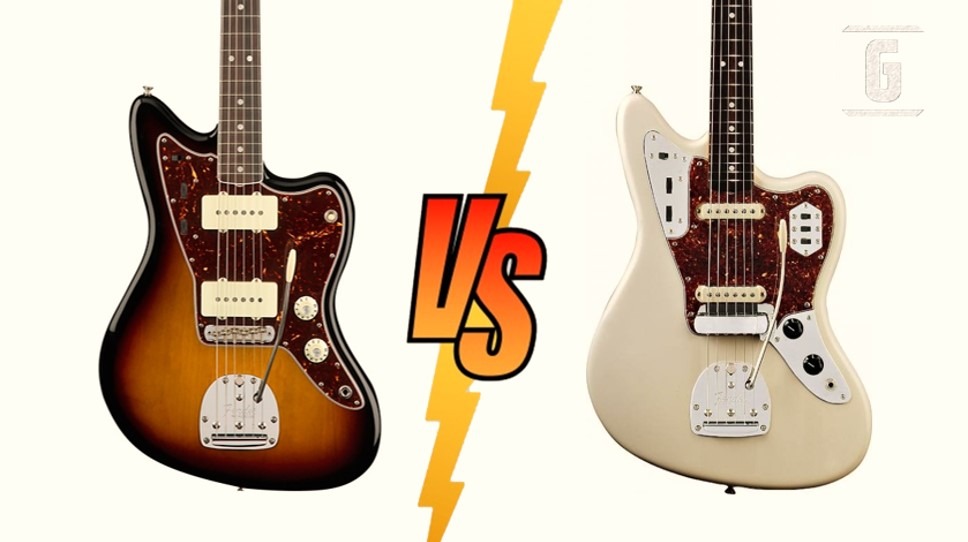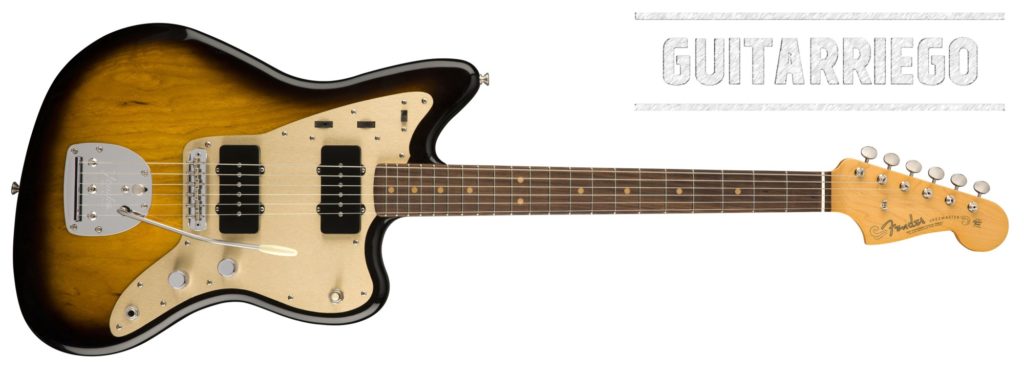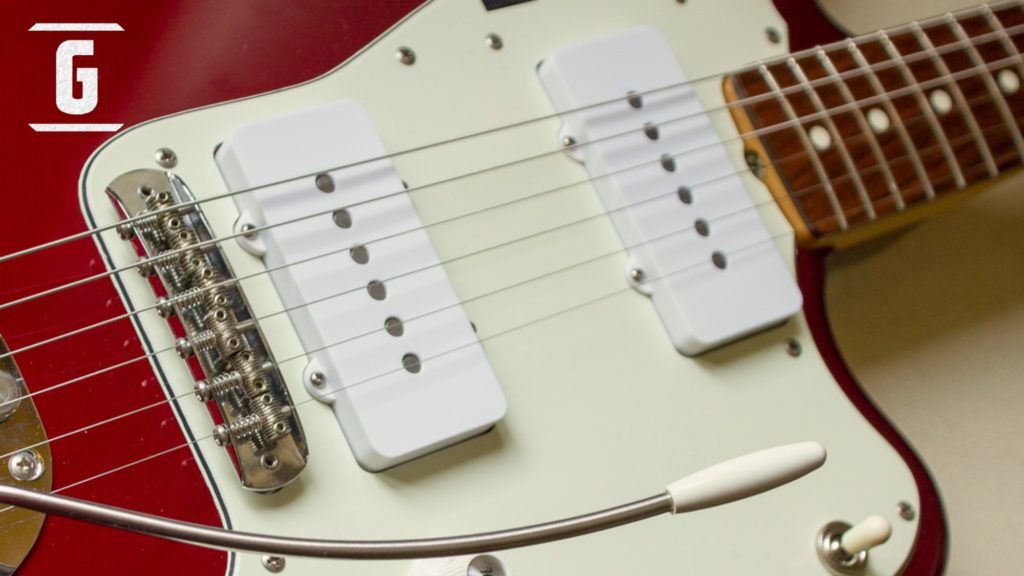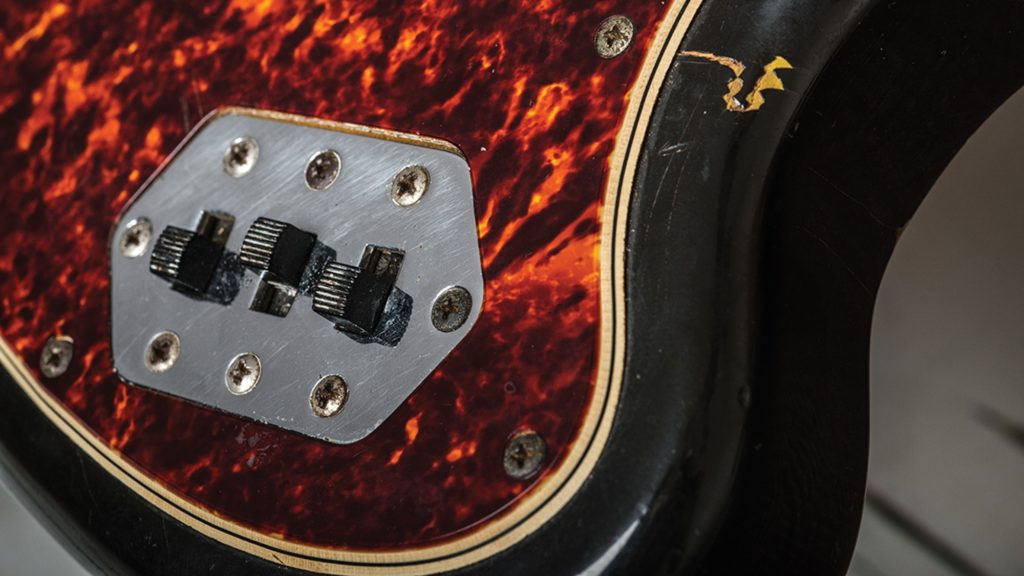Fender Jazzmaster vs Jaguar, characteristics and differences

Fender Jazzmaster vs Jaguar, two classic offset guitars, similar but different, we analyze their characteristics and differences, they also have their versions of Squier.
History of the Fender Jazzmaster and Jaguar
Fender Jazzmaster Released
In 1958, after releasing the Duo-Sonic and Musicmaster two years earlier, Fender introduces the Jazzmaster. This new model was a kind of deluxe guitar from Fender, being even the most expensive option to the Stratocaster.
Leaving aside the simplicity of the previous offset, the Duo-Sonic and the Musicmaster, simple and cheap studio guitars. A system of sophisticated controls to drive dual circuitry has been added to the new Jazzmaster. One circuit designed for rhythmic styles, and the other for a traditional style called Lead.
As its name implies, the Jazzmaster was designed to seduce Jazz guitarists, who were not attracted to the Telecaster and the Stratocaster. However, it was mostly used and popularized by Surf music artists and later by Alternative Rock and Indie musicians. Some major bands that used Jazzmaster are The Cure, Radiohead, Nirvana, and Sonic Youth, among others.
Another curiosity about the Fender Jazzmaster is that it was the first model that came with a rosewood fretboard as standard.

Fender Jaguar Launch
In 1962, Fender released the Jaguar, four years after the release of the Jazzmaster. Based on the Jazzmaster, with the same body shape and tremolo system, but with a short scale of only 24″ -inches-, 22 frets and an even more complex electronic system. The Fender Jaguar guitar was made to appeal to the Gibson user guitarist.
With some features similar to the Jazzmaster, such as the bridge, the fretboard radius, and the double circuit, but with some new features compared to its sister, such as the individual pickup switch.
Visit Guitar Quarter if you want to learn more about the history and models of the Fender Jaguar.
Fender Jazzmaster: Specs and Features
The Fender Jazzmaster has a 1-piece maple neck or maple neck with a rosewood fretboard with 21 frets. The neck profile is C and the fretboard radius is 7.25″. The inlays are dots and bone nut.

The offset-shaped body is solid with an offset shape and is usually made of ash or alder. It has forearm and rear recesses. It has the standard scale, that is, the same as that of the Telecaster and the Stratocaster, 25.5″ -inches- or 647.7 mm.
Tremolo lever and bridge from Fender Jazzmaster
The tremolo on the Jazzmaster is very different from that on the Stratocaster. This vibrato bridge is much more subtle and smooth than the Synchronized Tremolo on the Strat. It also has the «Lock Tremolo» that allows the tremolo to be locked so that if a string is cut the rest of the strings will not go out of tune due to the loss of tension. However, the tremolo is still functional, it can only be used by loosening the tension, not increasing it. When not locked it can be used in both directions.
The best bridge for the Jazzmaster and also the Jaguar, is the Mastery, which reduces friction when using the tremolo or vibrato lever and prevents the strings from slipping out of place.
Visit our note of the best tips to improve your tone as a guitarist.
Fender Jazzmaster pickups
Although the Pickups are aesthetically very similar to the P90, their construction and design is very different. It has a sound that maintains the crystal clear, dynamic and bright tone traditional and characteristic of Fender guitars, although with considerably more output, more kick and punch, than a normal single pickup.

Jazzmaster Electronics: Dual Circuit
The Jazzmaster guitar comes with a double circuit, on the one hand it has the Lead mode and on the other it has the Rhythm mode. With the switch located in the upper part of the pickguard, at the height of the 18th fret, you can select between these two circuits or modes.
Lead Mode or Circuit
The Lead mode or circuit would be the standard guitar circuit. The typical controls on any guitar are active: the master volume and tone knobs and the three-position switch. The pickups sound like a good Fender audio but with a more aggressive character than the brand’s classic.

Rhythm mode or circuit
The Rhythm circuit or mode is a novel circuit that only activates the neck pickup, but with a darker, warmer audio, ideal for rhythmic and jazz guitars, hence the name Jazz Master. This mode features a separate Volume and Tone wheel-type knob that sits above the neck pickup or Rhythm Pickup.
The difference in tone on the neck pickup between Lead and Rhythm mode is in the capacitor and the power value of the tone pot. These audio differences can be accentuated by having independent tone and volume for each of the modes.
Check out more rare Fender models in our Fender Fails Note: Ugly, Weird or Misunderstood Guitar Models.
Fender Jaguar: Specs and Features
The Fender Jaguar has a 1-piece maple neck or a maple neck with a rosewood fretboard with 22 frets, like the Gibsons. The neck profile is C and the fretboard radius is 7.25″. The inlays are dots and bone nut.

The solid body in offset shape is solid, usually made of ash or alder. It has forearm and rear recesses. It has a short scale like the Duo-Sonic and Mustang, 24″ -inches- or 609.6 mm.
We recommend that you read our guide on the parts of the electric guitar, their function and importance of each one in the operation and tone.
24-inch short scale features
Being shorter, the tension decreases and the strings are softer and softer to the touch, and the frets are closer together or smaller. Therefore, for general people, it becomes a more comfortable guitar, especially for guitarists with small hands. But also, it can make it difficult to finger on the higher frets as there is very little space left. Also, the string loses attack, sounds rounder and can even give more sustain.
Fender Jaguar Tremolo Lever

The tremolo on the Jaguar is the same as on the Jazzmaster. This vibrato bridge is much more subtle and smooth than the Synchronized Tremolo on the Strat. It also has the “Lock Tremolo” that allows the tremolo to be locked so that if a string is cut the rest of the strings will not go out of tune due to loss of tension. However, the tremolo is still functional, it can only be used by loosening the tension, not increasing it. When not locked it can be used in both directions.
We recommend our tutorial to improve the tone of your guitar.
Fender Jaguar Pickups
While the Jaguar Pickups are very similar aesthetically to the Stratocaster, they do have some differences. The Jaguar pickup is slightly wider, the poles are flush or “Flat” and it is mounted directly to the body and features a metal “claw” or “cage” that affects the magnetic field, output and tone of the pickup. Also, the metal “claw” reduces or filters Hum while remaining a classic singlecoil. Normally, it is described as a similar pickup but a bit brighter than a Strat and with less “air”, tighter. The magnet is usually Alnico V.

Jaguar Electronics: Dual Circuit
The Jaguar guitar, like the Jazzmaster, comes with the double circuit, Lead mode and Rhythm mode. With the switch located in the upper part of the pickguard, at the height of the 18th fret, you can select between these two circuits or modes. But unlike the Jazzmaster, it does not have a three-position switch for the pickups, but rather three switches, two that activate or deactivate each of the pickups and the third is a “Low Cut” or bass cut, also called “Strangle Switch”, which is nothing more than a capacitor that filters low or serious frequencies.
Circuit or Lead mode
The circuit or Lead mode would be the standard guitar circuit. The typical master volume and tone controls are active and instead of the three-position switch, it has the three switches that activate and deactivate each of the pickups and the Low Cut or Strangle.

Circuit or Rhythm mode
The Rhythm circuit or mode activates only the neck pickup, but with a darker and warmer audio. This mode features a separate volume and tone wheel knob that sits above the neck pickup or Rhythm Pickup.
The difference in tone on the neck pickup between Lead and Rhythm mode is in the capacitor -or condenser- and the power value of the tone pot. These audio differences can be accentuated by having independent tone and volume in each of the modes and the Low Cut or Strangle Switch in Lead mode.
If you want to know more about guitars, visit our guide to the history of the guitar: from classical to electric.
Fender Jazzmaster vs Jaguar: Differences and Similarities
What are the differences between Fender Jazzmaster and Jaguar?
The main differences of the Fender Jazzmaster vs Jaguar are:
- The scale: The one on the Jazzmaster is 25.5″ while the one on the Jaguar is 24″, which makes the strings softer to the touch and the frets closer together. Therefore, it becomes a more comfortable guitar, especially for guitarists who use Gibson, or with small hands.
- Pickups: The ones on the Jazzmaster look like a P90, but they keep the traditional Fender sound but with more output and kick. While those of the Jaguar are more similar to that of the Stratocaster with more brightness and less air, tighter.
- Pickup switch: While the Jazzmaster ‘s is a three-point or position switch, the Jaguar ‘s are independent switches similar to those on the Red Special.
- Control of “Low Cut” or Strangle : The Jaguar has a control that cuts low.
- Pickguard: While the Jazzmaster is all plastic or similar, the Jaguar has metal control plates.

What are the similarities between Fender Jazzmaster and Jaguar?
The main similarities of Fender Jaguar vs Jazzmaster are:
- The Body Design: The Jaguar takes the same offset body design as the Jazzmaster launched four years earlier.
- The shape of the Pickguard: both have the same shape, except that the Jaguar has metal «control plates».
- Tremolo and bridge system: Both have the same bridge and tremolo system, which Leo Fender considered to be the evolution of that of the Stratocaster.
- Double electronic circuit: although they do not share the same pickups and their selection system, nor the Low Cut of the Jaguar, both have the Lead and Rhythm Mode.
Fender Jaguar vs Jazzmaster : Which one do you like? What is your opinion about both electric guitars?
You may be interested in our guide with tips to improve your cheap electric guitar.






